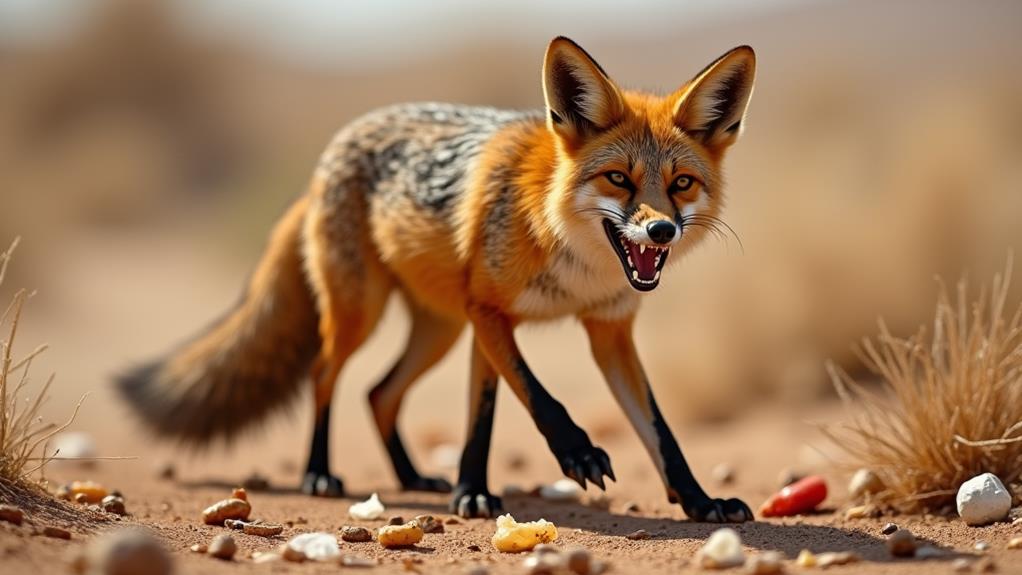Arabian red foxes might seem harmless with their adorable looks, but they can be dangerous. They're clever scavengers, often prowling around urban areas, making pets easy targets, especially in the nighttime when they're most active. Plus, these foxes carry diseases like rabies and Toxocara, which can affect both your pets and you if a bite occurs. As they adapt to city life, encounters with humans can lead to pesky conflicts, too, like rummaging through trash. So, keeping a close eye on your pets is essential! Stick with us, and you'll learn how to coexist with these charming critters safely.
Contents
- 1 Overview of Arabian Red Foxes
- 2 Adaptability to Urban Environments
- 3 Potential Threats to Small Pets
- 4 Diseases Carried by Foxes
- 5 Conflicts With Local Communities
- 6 Behavior and Foraging Habits
- 7 Public Health Risks
- 8 Conservation Status and Challenges
- 9 Coexistence Strategies With Humans
- 10 Final Thoughts
Overview of Arabian Red Foxes

The Arabian Red Fox (Vulpes vulpes arabica) is a remarkable creature perfectly suited for desert life. Weighing around 2.7 kg, this little fox has some fascinating adaptations. With bigger ears, a smaller body, and a lovely brownish-pale red coat, it can regulate its body temperature in the scorching heat.
Its furry toes even help protect it from hot surfaces—talk about stylish and practical!
These foxes are mostly solitary, roaming their temporary home ranges in search of food, which includes rodents, birds, fish, and even the occasional desert veggie.
And guess what? They're primarily nocturnal, so you might hear their distinctive vocalizations echoing through the night instead of barking domestic animals.
When it's breeding season in the spring, they may have litters of 2 to 5 kits, which grow up fast! By about 6-8 weeks old, these little ones are weaned and ready to explore their desert playground.
While the Arabian Red Fox could be considered a charming critter, its wild nature doesn't quite match our friendly domestic pets.
Understanding these unique behaviors helps us appreciate the beauty of nature and promotes kindness toward all creatures.
Adaptability to Urban Environments
Adapting to urban environments, Arabian Red Foxes showcase their remarkable survival skills. These clever little critters have found a way to thrive even when their natural habitats shrink.
With those big ears and a slender body, they're perfect for handling the heat and conditions of urban deserts. Urban-dwelling red foxes have greatly increased in numbers, demonstrating impressive urban fox adaptation strategies. You might spot them sneaking around at night, using the cover of darkness to forage for food while staying clear of human activity.
Their adaptability shines through as they take advantage of diverse food sources, munching on everything from rodents to the leftovers from your late-night pizza. It's surprising how well they find nourishment in urban areas, proving they're resourceful little scavengers!
However, this newfound urban life brings them closer to humans, which might spark some concerns about their behavior—especially when food gets hard to find.
Just remember, these foxes aren't out to chase you down; they're merely trying to make the best of their situation. So, next time you see one, appreciate their resilience. They might just be the most adaptable neighbors you'll encounter in the city!
Potential Threats to Small Pets

Living in close proximity to Arabian red foxes can pose potential threats to small pets, especially if they're left unattended. These clever little predators see small pets as opportunities for a meal, particularly young dogs and cats.
When you consider their diet, which includes small mammals and birds, you can see why keeping an eye on your furry friends is vital.
Arabian red foxes usually weigh around 6 pounds, making them surprisingly agile and capable of sneaking up on a small pet that's roaming outside. Unfortunately, they often establish denning areas near human homes, especially in urban settings, which raises the likelihood of encounters.
It's especially concerning during the nighttime hours since these foxes are nocturnal, and that's when your little companions face a higher risk.
To keep your pets safe, it's important to supervise them closely, particularly in the evenings. If you're ever tempted to leave them outside for a quick break, think again! It's better to play it safe.
Diseases Carried by Foxes
Having small pets near Arabian red foxes raises concerns beyond direct predation; these clever animals can also carry various diseases that pose risks to both pets and humans.
You mightn't realize it, but the presence of these foxes can introduce a slew of parasites that could sneak into your backyard.
Here are a few diseases to watch out for:
- Toxocariasis: Caused by Toxocara canis, this could lead to serious health problems if accidentally ingested through contaminated soil or feces.
- Alveolar Echinococcosis (AE): This nasty zoonotic parasite, if left untreated, could become life-threatening, though its occurrence is pretty rare in the UK.
- Trichinosis: Linked to Trichinella spiralis, this can leave you feeling muscle pain and fatigue.
And let's not forget about rabies! It's a major concern where foxes roam, meaning keeping an eye on local populations is essential.
While some fox diseases might seem like they're far away, it's wise to be proactive about the health of your pets and family.
After all, when it comes to health, an ounce of prevention is worth a pound of cure!
Conflicts With Local Communities

Conflicts between Arabian red foxes and local communities often arise as these clever creatures venture into urban areas in search of food and shelter. Their increased adaptability allows them to exploit various environments, including residential areas where leftovers and scraps are plentiful, and you might find them rummaging through your trash or eyeing your backyard pets.
It's not that they're mean; they're just trying to survive, especially during the breeding season when kits need extra food. Unfortunately, this can create quite a headache for farmers and pet owners.
When Arabian red foxes get a little too close for comfort, they sometimes target small livestock or poultry, leading to economic losses for local producers. Imagine putting in all that hard work, only to see a sly fox snack on your young animals!
Additionally, as urbanization shrinks their natural habitat, these encounters become more frequent. Urban foxes often rely on human food scraps, which can escalate conflicts as they become more daring in their search for sustenance urban adaptability strategies.
It's important to remember that public perception can sometimes make matters worse. When folks view foxes solely as pests, they might resort to misguided control measures.
Instead of escalating conflicts, let's focus on finding solutions that respect both the livelihood of farmers and the survival instincts of these fascinating creatures. After all, we share this space and can coexist with a little understanding and effort.
Behavior and Foraging Habits
When you think about Arabian red foxes, picture these clever little creatures scurrying around under the moonlight.
They've mastered the art of nighttime foraging, using their sharp senses to hunt and snatch up their meals while most of us are tucked in bed.
Nocturnal Foraging Strategies
Under the veil of night, Arabian red foxes employ a range of strategic foraging behaviors that make them successful hunters in their arid habitat. You might think of them as the stealthy ninjas of the desert.
These nocturnal creatures maximize their chances of finding food by using their keen senses and clever tactics.
Here's what you should know about their foraging habits:
- Exceptional Hearing: Their large ears help them pick up the tiniest sounds, like a mouse having a midnight snack.
- Stealth System: They sneak around quietly, sniffing out dinner hidden beneath shrubs or in burrows.
- Solitary Skills: By patrolling their home ranges, they make sure they know where the best food spots are—kind of like their personal buffet!
Despite their small size, these foxes can tackle prey much larger than themselves. Talk about resourcefulness!
Habitat Utilization Patterns
Arabian red foxes display remarkable adaptability in their habitat utilization patterns, allowing them to thrive in various environments. You'd be amazed at how these clever creatures navigate the desert, mountains, coasts, and even urban areas!
Being primarily nocturnal helps them dodge daytime predators and human activities while they forage for food.
Their diet is as diverse as their habitats, consisting of rodents, birds, fish, desert vegetation, and even carrion. This flexibility in food sources showcases their adaptability, which is essential for survival in harsh conditions.
They aren't picky eaters, making mealtimes a bit of an adventure.
These foxes lead a nomadic lifestyle, creating temporary home ranges that shift based on food availability and environmental conditions. You can think of them as the wanderers of the desert, always on the move!
Their larger ears and fur between their toes help them handle the heat, making them perfectly suited for their hot surroundings.
Public Health Risks

You mightn't think of Arabian red foxes as a threat, but there are some health risks to keep in mind.
These clever little creatures can carry parasites and diseases that humans can catch, especially in urban areas where they might get a little too friendly.
Zoonotic Disease Transmission
Zoonotic disease transmission poses significant public health risks associated with Arabian red foxes, as these animals can host various parasites that affect human health.
It's crucial to be aware of these risks if you're living or working in areas where these clever creatures roam. Here are some of the most concerning zoonotic parasites they might carry:
- Toxocara canis: Can cause toxocariasis in humans, leading to serious health issues like ocular and visceral syndromes.
- Echinococcus multilocularis: While more common in colder climates, it can lead to a serious illness if not treated.
- Rabies: Fox populations can carry it, posing a significant risk when they interact with your beloved pets or even you!
Staying informed and vigilant helps protect your health and that of others.
Fortunately, routine screenings in the UAE show low risks from some parasites, like Trichinella spiralis.
Nevertheless, it's imperative to keep an eye on fox health through monitoring programs.
Healthy steps today can prevent a potential "hairy" health scare tomorrow, so let's spread the word and help keep our communities safe!
Urban Interaction Risks
As urban areas grow, the risks associated with interacting with Arabian red foxes become more pronounced. You might enjoy spotting these clever creatures while walking in your neighborhood, but it's important to remember that urbanization brings challenges.
As foxes adapt to city life, they often scavenge for food, increasing the chances of disease transmission. Their feces can harbor zoonotic parasites like Toxocara canis, which can lead to toxocariasis in humans if you accidentally ingest eggs from contaminated soil or surfaces. Yikes!
The more foxes encroach on urban spaces, the higher the possibility of close encounters. This can lead to bites or scratches, which may require medical attention or rabies vaccinations. While not all foxes are aggressive, you never know how a wild animal might react, especially if it feels threatened.
So, it's better to keep a safe distance and not approach them. In our quest to coexist with nature, let's also look out for each other's health.
Aggression and Rabies Threats
The Arabian red fox's increasing presence in urban areas raises valid concerns about aggression and rabies threats. While these clever creatures usually avoid humans, they can become aggressive if they feel cornered or threatened. This is especially true when rabies is in the picture.
You might be thinking: what does this mean for you?
- Rabid foxes can act unpredictably, leading to potential aggression towards people and pets.
- Monitoring rabies outbreaks is essential, even if cases have declined recently.
- Quick medical help is critical for anyone bitten or scratched by a fox that seems a bit off.
It's important to be aware of these risks, especially if you live in areas where wildlife and urban life mix. The dangers of rabies can be serious, but you can take steps to keep yourself safe.
Always keep an eye out for any strange behavior from animals, and avoid approaching wildlife. We want to cherish our environments, but being cautious safeguards everyone's well-being—both human and animal.
Conservation Status and Challenges
What challenges do Arabian Red Foxes face in their struggle for survival? These fascinating creatures, with their playful nature and bushy tails, are classified as "Near Threatened."
Habitat loss is a big issue, especially as urban areas expand in the UAE. As humans encroach on their homes, these foxes find their natural habitats shrinking, leading to fierce competition for food and shelter.
Moreover, similar to other fox species like the Red Fox, they often thrive near urban areas but face unique challenges in densely populated regions. You might be surprised to know that these clever animals often find themselves dodging traffic as they navigate roads, which can be a deadly game!
It's not just cars that threaten them; climate change adds another layer of difficulty. Changes in climate can affect their food sources and suitable living environments. Without a reliable habitat, these charming little critters face tough odds.
Sadly, conservation efforts hit a snag due to a lack of detailed data on their populations and where they like to hang out. It's hard to help when you don't know how many foxes are out there!
Every effort counts, though, so if you're looking to make a difference, supporting local conservation initiatives can be a great start! Let's help guarantee these foxes can still frolic in the wild for generations to come.
Coexistence Strategies With Humans

While Arabian red foxes face numerous challenges due to habitat loss and climate change, finding ways to coexist with humans is important for their survival.
By adopting simple coexistence strategies, we can foster a safer environment for both foxes and our communities. Here are a few steps you can take:
- Secure trash and outdoor food items to keep foxes from checking out your backyard buffet.
- Educate yourself and others about the essential role these foxes play in the ecosystem, reminding people that they're not just cute but significant helpers in pest control.
- Supervise small pets and keep them indoors during the foxes' active hours, especially at night, to protect them from potential encounters.
Final Thoughts
So, while Arabian red foxes might not be the cuddly companions you're hoping for, they play an essential role in their ecosystem. It's all about balance! By understanding their habits and being mindful of your pets, you can enjoy the beauty of these clever creatures without too much worry. After all, they're just trying to find their place in the world, just like all of us. With a little respect and awareness, we can coexist harmoniously!














